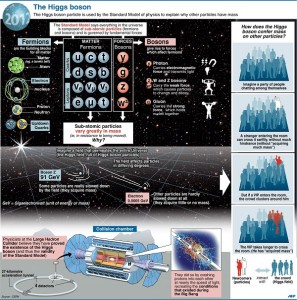Higgs evidence mounts one year on, so too the suspense
PARIS—A year since the discovery of a subatomic particle set the science world aflutter, evidence is mounting it may be the elusive Higgs boson even as researchers warn the suspense is far from over.
“We have established without a doubt that we have a new particle, and that it is a boson. What remains to be done is confirm that it is a Higgs,” said physicist Pauline Gagnon, a member of the team that made the discovery at the European Organization for Nuclear Research (CERN).
The elusive boson dubbed the “God Particle” was theorized by British physicist Peter Higgs in 1964 to be what gave mass to matter as the Universe cooled after the Big Bang.
Guided by the theoretical work of Higgs and others, hundreds of scientists have been on a single-minded boson quest for over three years at the CERN’s atom-smashing Large Hadron Collider (LHC).
On July 4 last year, physicists announced to rousing applause that they had found an elementary particle “consistent with (the) long-sought Higgs boson” — a scientific milestone.
Finding the Higgs would fill a massive gap in the Standard Model of particle physics, which describes the forces, particles and interactions that comprise the Universe.
In theory, the Higgs exists as an invisible field, interacting with other particles to give them mass. Without it, humans and all other joined-up atoms in the Universe would not exist.
But while the Standard Model postulates the existence of a single Higgs boson, alternative schools of thought like string theory say there may be at least five.
“Have we found THE boson, or perhaps one of several predicted by other theories …? Until now, everything indicates that this is the Standard Model boson,” Gagnon told Agence France-Presse.
“It has the allure, the look, the song and the dance of the Higgs boson.”
Over the past year, physicists have analyzed at least 2.5 times the amount of information they had available at the time of the 2012 announcement.
And they have said the particle now appears to have at least two of the main characteristics expected of a Higgs.
In theory, a Higgs boson should have zero “spin,” a measure of momentum. And “parity” — a measure of how its mirror image behaves in quantum physics — should be positive.
Having analyzed mountains of data, the CERN said in March the available data pointed to “no spin and positive parity”.
“It is all shaping up exactly the way it should. Everything we look at looks more and more like a Higgs boson,” said Bill Murray, deputy physics coordinator for the ATLAS experiment at CERN.
“We haven’t seen anything that doesn’t look at all the way a Higgs boson should. We have some small tensions in the data with one or two pieces that are not exactly the way you would expect… but this is not particularly significant.”
More data needed
New findings are expected to be unveiled at a conference of the European Physical Society in Stockholm in July, but Gagnon stressed much more data is required for science to be convinced of the particle’s identity.
As for Murray: “I’m not sure one will ever say this is the Standard Model Higgs boson.
“We will never be able to say it is the only one because there always could be one that is so incredibly heavy that you could never… make it” in the LHC.
Ironically, some would prefer the discovery of more than one Higgs, added Gagnon.
“Finding just one would confirm the Standard Model”, which describes only about five percent of what the Universe is made up of, she explained.
The LHC, straddling the border between Switzerland and France, shut down last month for a two-year revamp that should allow bigger collisions and the creation of heavier particles, perhaps other Higgs bosons.
But whatever proof it yields may never be conclusive.
In science, explained Murray, “you can never prove something is right, you can only ever prove something is wrong.
“All we can do is rule out more and more alternatives.”
